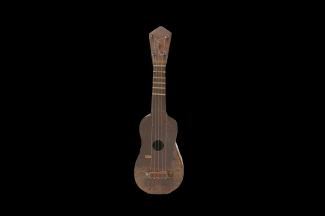Tugu Village, Jakarta, circa 1940
Keroncong Tugu music, traditionally played using instruments like this macina, originated in Tugu village, North Jakarta. This genre was developed by the Mardijkers—descendants of Portuguese-speaking slaves brought to Batavia (modern Jakarta) by the Dutch East India Company. These people hailed from former Portuguese colonies across Asia, including Malacca (now Malaysia) and coastal India.
Initially, Keroncong Tugu was performed at harvest festivals and family gatherings. Today, it is a popular genre across Indonesia. The Tugu community still speaks a creole language rooted in Portuguese, and many of their songs are performed in this language, preserving this cultural heritage.
Driven by the spice trade and missionary ambitions, the Portuguese were the first Europeans to establish a colonial presence in the Indonesian islands in the early 16th century. While there is no evidence of Portuguese reaching Australia, folklore there tells stories, including that of a Portuguese "mahogany ship" wrecked on the southwest coast of Victoria.
Inventory Number: MSJ/ETG/ALM/0151
Material: Cananga Flower Wood
Dimensions: Height 56 cm
Nur Hilalluddin, Kurator, UP. Museum Kesejarahan Jakarta, discusses the significance of the macina and Keroncong Tugu music.
Curators
Fendrik Saputra | Jakarta History Museum
Nur Hilaludin | Jakarta History Museum
Mohammad Hafif | Jakarta History Museum
Nani Mawarni | Cultural Heritage Protection Division, Jakarta Department of Culture







